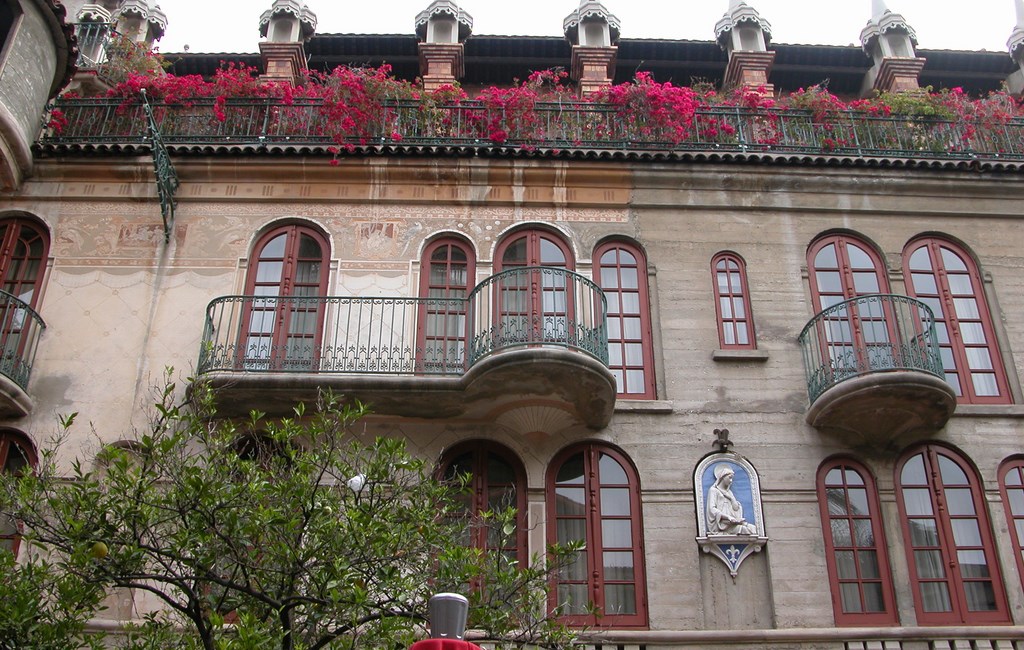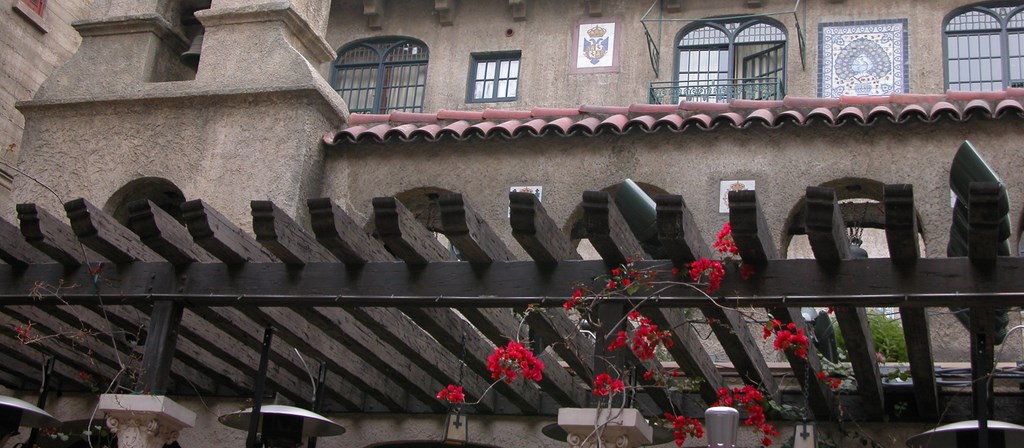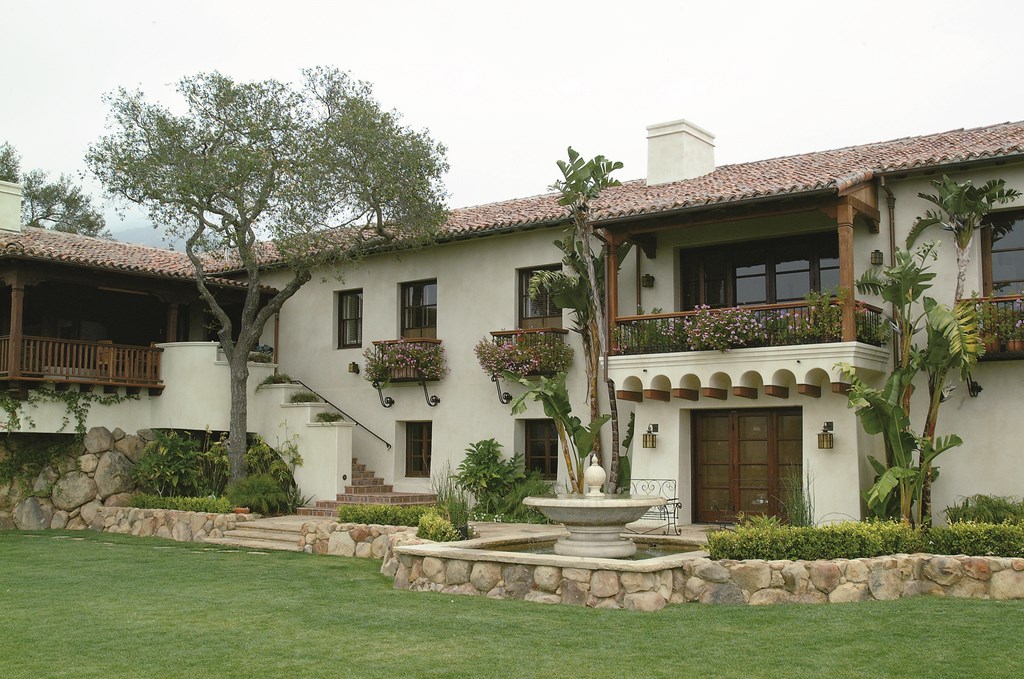Spanish Colonial Keys

In my years as a practicing landscape architect, I’ve found that designers love in particular to borrow elements from the Spanish Colonial style of architecture. In fact, it has become one of the most important and influential of all architectural forms.
This archetypal architecture flourished between the 16th and early-19th centuries in the New World and is based upon historical models established in Spain – but developed its own unique features in different regions as Spain’s empire grew and was influenced by various cultures under its sway. By the time the colonial period ended, in fact, the style was a mélange of Spanish and Moorish forms along with elements adopted and adapted from indigenous artisans of Peru and Mexico, among others.
The concept of the “villa” is the prime reason the Spanish Colonial style has been so avidly celebrated and followed: We travel great distances the world over to spend our vacation time in comfortable settings patterned on the villa concept, with details such as verandas, courtyards, thick walls, archways and porticos all coming to mind when we envision settings tailor-made for luxurious relaxation.
| White plaster is the finish of choice for an abundance of structures in the Spanish Colonial style (left). It’s a feature that serves to make a variety of other details stand out, including floor and roof tiles in the characteristic red hues of terra cotta — another authentic visual feature of Spanish Colonial architecture (middle). Colorful tiles, however, are a later addition from the Spanish Colonial Revival of the early 20th Century and form a key enhancement of style’s vocabulary (right). |
In material terms, these architectural details are made up of four specific materials – white plaster, terra cotta, iron and wood – around which just about all of the appeal of the Spanish Colonial style revolves. When these materials are combined in the right ways, they can be used to reflect aesthetic and practical roots that reach back to the origins of Western architecture.
[ ] White Plaster: The flesh of Spanish architecture is its white or light-colored plaster – the medium that binds all the other elements together. Whether it’s an arch, a turret or a simple wall, plaster is troweled using many techniques and textures as an expressive sort of monochromatic fresco that brings the style to life.
| The elegant, organic forms found in ironwork of Spanish Colonial buildings is a definite hallmark of the style – especially when the material is unfinished and left to the elements (left). So are the rough-hewn timbers that characterize shade structures, balconies and doorways (right). |
A simple wall can become a work of art at the hands of a plasterer capable of working in the many “knock-down” finishes known today. If there ever was a negative-space element that has been a binding factor for art, it would be this form of plaster.
[ ] Terra Cotta: Whether it’s high-fired or sun-baked, terra cotta embodies the colors of Spanish Colonial architecture. Used as paving units or in the form of the S- and C-shaped roofing tiles that protect structures from rain while allowing a great deal of hot air to escape the structure, these elements are intimately associated with the style.
While the roofing tiles have been fairly static in form, the pavers are a red tapestry upon which a vast array of creative patterns have been woven. In the early 1900s, the Catalina Tile Co. became famous for richly embellishing simple tiles embossed with Moorish geometric patterns in striking (and sometimes garish) colors.
| On occasion, all of the elements – white plaster, terra cotta, iron and wood – are used in ways that show off the unusual elegance and simple beauty of the Spanish Colonial style. |
This contrast to the simple hues of Spanish Colonial architecture became the signature of the Spanish Colonial Revival of the early 20th Century, and much of it can be traced to the free-spirited colorations of Mexican art and culture – the main conduits by which Spanish Colonial style was conveyed to the United States.
[ ] Iron: Hand-forged iron is the decorative scrollwork of Spanish Colonial architecture. Indeed, if hand-painted tile is its most visually striking component, then iron is its most elegant.
Stair and balcony railings, door and window hinges and straightforward, lantern-style light fixtures were all made of iron. Draped across the architecture like jewelry, these ornaments were never painted, gilded or treated in any way: Iron in Spanish Colonial architecture was always raw black, with only the natural colors of oxidation serving to highlight its sweeping, organic contours.
[ ] Wood: The exposed beams that visually characterize Spanish Colonial architecture usually take the form of either rafter tails or balcony supports, and where you might encounter a richly decorated, hand-carved front door made of wood, most of the wooden elements are entirely functional.
|
Resources: Before delving into a Spanish Colonial-flavored project, I suggest doing some research and taking a look at some or all of these books: [ ] Casa Columbiana: Living in the Latin Style by Benjamin Villegas (Chronicle Books, 1995) [ ] The Gardens of Spain by Consuelo M. Correcher (Harry N. Abrams, 1993) [ ] Moorish Architecture in Andalusia by Marianne Barrucand (Taschen, 1992) [ ] Casa California: Spanish Style Houses from Santa Barbara to San Clemente by Elizabeth Jean McMillian (Rizzoli, 1996) [ ] Catalina Tile of the Magic Isle by Lee Rosenthal (Windgate Press, 1992)— M.H. |
Rich in visual impact but simple in form, these structural wood members are often dark in color and are always rough-hewn. When I work in this form, we will burn, gouge, stain, paint and then sandblast the timbers to recreate the wood’s rugged appearance and mimic the effects of time.
Using any of these elements in combination to shape walls, rails, pathways or other landscape elements can be greatly enhance any design that even hints at Spanish Colonial style, and using them in combinations only strengthens the appeal inherent in this time-tested style.
In most of my projects, I work with design elements from diverse styles, depending on the setting and its needs. When I’m working specifically with Spanish Colonial architecture, however, I tend to become a purist who sticks to tried-and-true design principles and details.
I do so for the simple reason that it enables my clients to enjoy – to the fullest extent possible – settings that radiate feelings of comfort, relaxation, and luxury.
Mark Holden is a landscape architect, pool contractor and teacher who owns and operates Holdenwater, a design/build/consulting firm based in Fullerton, Calif., and is founder of Artistic Resources & Training, a school for watershape designers and builders. He may be reached via e-mail at [email protected].
















